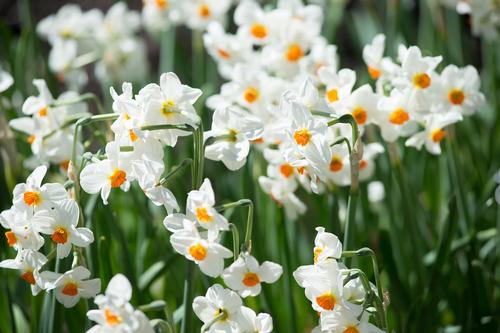FAQS - FALL PLANTED BULBS
Wondering how to care for your tulips, daffodils, hyacinths and other fall-planted bulbs? Here are answers to some common questions that we receive from our customers. If your question isn't addressed below, please send us an email or give us a call at: 855-534-2733.

What types of flower bulbs should be planted in the fall?
Most spring-blooming flower bulbs are planted in the fall. These include tulips, daffodils, hyacinths, crocus, alliums, scilla and Dutch iris. For tips on color themes and planting techniques, you may be interested in reading: How to Plan a Spring Bulb Garden.
When should I plant my bulbs?
Spring-blooming bulbs are planted in mid to late fall. The ideal time is after the first killing frost, when you are raking leaves and doing other fall cleanup chores. There is no need to rush. As long as the ground can still be worked, you can go ahead and plant your bulbs -- even if it’s December. If possible, your bulbs should have a couple weeks to grow roots before they enter winter dormancy. For a map that shows when to plant based on your region, click HERE.

How should I store my flower bulbs until it’s time to plant?
Open the box as soon as it arrives and put it in a cool, dry place at 50-60°F. Keep the bulbs away from sunlight, heat and freezing temperatures. We recommend leaving the bulbs in their plastic packages to help keep them from drying out.
Where should I plant my spring blooming bulbs?
Spring-blooming bulbs prefer full sun, but because they bloom before the trees leaf out, even a shady area will provide plenty of sunlight. Consider adding bulbs to your flower garden for early season color. Plant them along a walkway or in your front yard for curb appeal. Daffodils and smaller bulbs can be planted beneath trees and shrubs, and in lawns and woodlands. Plant tulips and hyacinths in a cutting garden for beautiful spring bouquets. Most spring bulbs may also be grown in containers.

How should I plant my fall bulbs?
Bulbs should be planted in soil that is loose and well-drained. They will not grow in soggy soil. Start by loosening the soil a little deeper than the recommended planting depth. As a general rule, bulbs should be planted 2 to 3 times deeper than their height. This means a 2½” tall tulip bulb should be planted 5 to 7” deep. Refer to the package for the proper planting depth or read the appropriate All About article HERE.
Spring-blooming flower bulbs look best planted in groups of 5, 10 or 25 bulbs. Informal, irregular clusters have a more natural look than straight rows. You’ll find planting videos and other helpful information HERE.
How do I know which part of the flower bulb should face up?
Most bulbs have a flattened bottom (root end) and a tapered top (stem end). When planting, the tapered end of the bulb should face up. If you can’t determine bottom from top, just plant the bulbs on their side and they will naturally grow toward light and warmth.

I live in a warm climate. Do I need to pre-cool my fall-planted bulbs?
Dutch iris and some varieties of daffodils will perform well in zones 8-10 without any special care. Simply plant the bulbs in the fall and they will bloom the following spring. Most other bulbs, including tulips, hyacinths, alliums and crocus, must be exposed to at least 8 weeks of consistently cool temperatures (below 45°F) in order to flower properly. Depending where you live, your bulbs may need to be pre-chilled before planting. Learn more here: How to Grow Spring Bulbs in Warm Climates.
I forgot to plant my bulbs in the fall. Can I wait and just plant them in spring?
Inside every bulb is a living plant that can't survive more than 4 or 5 months out of the soil. If your bulbs still feel dense and firm, you can try planting them outdoors in late winter. Be aware that most spring-blooming bulbs need to go through several months of cold temperatures in order to bloom properly. So even if the bulb grows, it may not flower.

What happens if we get a late snow after my flower bulbs start growing?
Flower bulbs don’t mind cold temperatures. Crocus and snowdrops often bloom while there’s still snow on the ground. Even if the plant’s foliage gets crushed by snow, it will usually bounce back without lasting damage.
How do I keep deer away from my flower bulbs?
The best solution is to plant bulbs they won’t eat, such as daffodils, alliums and chionodoxa. If deer are a problem in your area, you’ll find suggestions here: How to Protect Your Garden from Deer.
